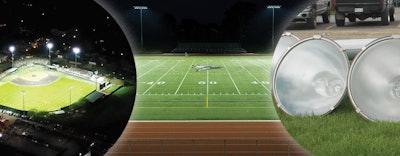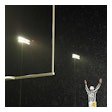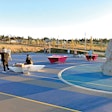
One high school wished to control light spilling from its multipurpose field so neighbors would no longer feel the need to drape blankets over their windows at night. Another school wanted to improve athlete safety on its soccer field by replacing 18-year-old fixtures that had degraded to such an extent that spill light was of little concern. A university sought to intensify its baseball field lighting to broadcast levels with an eye toward one day hosting NCAA postseason play.

The reasons institutions give for upgrading their outdoor field lighting may be varied, but the results are invariably positive. State-of-the-art technology has made it easier than ever for facility operators to focus quality light where it belongs — on the field — and nowhere else. But there are still choices when purchasing a new lighting system. Three end users describe their decision-making process:
![[Photo courtesy of Musco Lighting]](https://img.athleticbusiness.com/files/base/abmedia/all/image/2018/05/ab.lighting518c.png?auto=format%2Ccompress&fit=max&q=70&w=400) [Photo courtesy of Musco Lighting]
[Photo courtesy of Musco Lighting]
Wakefield High School
After weighing their options, officials representing both the high school and the parks and recreation department in Wakefield, Va., opted to replace the existing metal halide system at the multisport field on school grounds with LED technology offered by the same manufacturer — Musco Lighting.
The decision was informed by recent lighting upgrades to the school system's interior hallways and classrooms, as well as its parking lots. According to Cathy Lin, energy manager for Arlington Public Schools, trading in 300 1970s-era fixtures for 150 fixtures with LED technology saves $50,000 annually in one middle school gymnasium alone. "We've noticed a huge improvement when we've upgraded to LED with regard to maintenance and operation," Lin says. "We're spread pretty thin. It really improves not only the light quality of our spaces, but also reduces our operations and maintenance costs and time."
That made transitioning to LEDs at the multipurpose field, where synthetic turf is surrounded by a track, less of a leap. Still, the $490,000 installation represents the first outdoor LED sports lighting in Arlington County, says Lin, adding that the partnership with parks and rec means the lights are used essentially year-round. "I've been a resident for more than 20 years," she says. "We have a lot of community members who like to run on the track in the evening and on the weekends, even in the wintertime."
In the past, roving parks and rec personnel would have to arrive onsite to manually turn lights off, and there were occasions when an oversight resulted in field lights burning all night — drawing heat from neighbors in the spill zone. That issue has been mitigated by Musco's control options, allowing the lights to be programmed for automatic shutoff. "Say you know you're going to have a football game on Friday and you need the lights on at 6 p.m. You can schedule it to shut off at 10:30 p.m.," Lin says. "The beauty of it is that it shuts off in the evening so it doesn't disturb the neighborhood."
Even with the new foolproof programming capabilities, potential spill light during hours of operation was still uppermost on Lin's mind. The upgrade to LED actually allowed for the elimination of two entire poles full of lights. "We went from six poles to four, which was an improvement in terms of the light spill," Lin explains. "We're in a very urban community. We're very tight with neighborhoods. Where we had three light poles along the visitors' side before, now we only have two, and we've brought them in closer to the field. Before they were closer to our property line and the neighbors. I was adamant when we were managing this project that we could not have any light spill into the neighborhood."
Meanwhile, average light levels on the field have doubled — from around 25 foot-candles to 50.
![[Photo by Jessica Potila/St. John Valley Times]](https://img.athleticbusiness.com/files/base/abmedia/all/image/2018/05/ab.lighting518b.png?auto=format%2Ccompress&fit=max&q=70&w=400) [Photo by Jessica Potila/St. John Valley Times]
[Photo by Jessica Potila/St. John Valley Times]
Fort Kent Community High School
A farming and logging community of 4,000 located along Maine's border with Canada, Fort Kent was faced three years ago with a pair of related problems: a soccer field surrounded by failing lights atop poles only a woodpecker could love, and a school athletics budget that wouldn't allow much to be done about it. A booster club of parents and business leaders formed, and the $80,000 relighting of the field remains its biggest project to date, according to Lynn Plourde, the club's president since its inception.
![[Photo by Jessica Potila/St. John Valley Times]](https://img.athleticbusiness.com/files/base/abmedia/all/image/2018/05/ab.lighting518b2.png?auto=format%2Ccompress&fit=max&q=70&w=400) [Photo by Jessica Potila/St. John Valley Times]
[Photo by Jessica Potila/St. John Valley Times]
"On top of donating financially to the club every year, local businesses also donated all of their equipment, all of their manpower, and completely took the cost of that and swallowed it to put these lights in. It was a pretty cool thing," Plourde says. "The lights we had were archaic, and the cost of repair, the cost of simply lighting them, was high. We raised the $80,000 within two years to pay for this."
Cost and warranty were what steered the boosters in the direction of Qualite Sports Lighting for the new lighting system. Opting for metal halide over LED saved $20,000, according to Plourde, who says the seasonal usage of the field didn't allow energy efficiencies and lifecycle savings of LEDs to justify a larger upfront investment. "We only use this for a few months out of the year, so we didn't feel it was feasible," she says. "Had it been in a gymnasium, we probably would have gone with LED, because it's used more."
In addition to the lighting upgrade, Fort Kent's field now features four aluminum poles that stand 20-feet shorter than their wooden predecessors for ease of maintenance — each supporting eight fixtures instead of the previous 12. "Our poles were 85-foot poles, so maintaining the lights at the top of each pole was a nightmare," says Plourde, adding, "Some poles were actually rotting, and we also had woodpeckers that were kind of making their home there. It was affecting the wiring, and we had some shortages. It came to the point where our lights weren't even aiming where they needed to be aiming, not to mention the black spots from burnouts. It just wasn't evenly spread throughout the field."
![[Photo courtesy of GeoSport Lighting LLC]](https://img.athleticbusiness.com/files/base/abmedia/all/image/2018/05/ab.lighting518a.png?auto=format%2Ccompress&fit=max&q=70&w=400) [Photo courtesy of GeoSport Lighting LLC]
[Photo courtesy of GeoSport Lighting LLC]
Southeastern Louisiana University
Typically, the choice to go with LED lighting translates into a reduction of fixtures. Not so at SLU.
"We had 90 fixtures prior to the retrofit, and now we have 155," says senior associate athletic director Andrew Bechac of the Eaton's Ephesus lighting in place at the school's baseball stadium since March. "We wanted to go to the NCAA best practices for sports lighting, and we wanted to reach the national and regional broadcasting levels for foot-candles."
Mission more than accomplished. Whereas the NCAA's broadcast requirements set foot-candle thresholds at 100 on the infield and 70 in the outfield, SLU's new system is hitting 125 and 85, respectively. Moreover, it's controlling all that light. The previous lighting at Alumni Field escaped into the adjacent street and across to nearby residences. "One of the benefits, of course, of going with LED is that pinpoint accuracy of the lighting," Bechac says. "You're always going to have some type of spillage, but the amount of spillage from prior to current is night and day."
Another selling point of LED technology is that it's lightweight. Wind-load tests showed that SLU's extra fixtures could be loaded on additional crossbars atop existing poles. This allowed the design to illuminate in ways the previous system did not. "We had some areas outside of field lighting where we added fixtures, as well — for example, in our bullpen area," Bechac says. "We have a bullpen outside of the stadium field but within the footprint of the pole. We were able to utilize some additional fixtures to replicate in the bullpen the exact foot-candle measurement that the pitchers would then see on the mound, so there would be no transition."
It's too soon to tell exact energy cost-savings on the new system, but Bechac believes the stadium will see a 25 to 30 percent reduction in energy use and expenses over time. And given the longevity of LED lights, he also expects additional annual relamping savings of $4,000 to $6,000. "You have to factor not just the actual ballasts and bulbs, but you have to pay for the hourly rate for an electrician to go up on a lift and change those," says Bechac. "There were costs beyond just the actual pieces of equipment that needed to be changed. So there may be an upfront cost, but there are savings on the back end."
Finally, the LED option has afforded SLU the ability to have some fun. Several different lighting "scenes," as Bechac calls them, can be summoned from a laptop to enhance what's happening on the field. There's a setting that illuminates only the "S" logo behind home plate, where the national anthem singer appears, as well as the American flag in center field. There's a pinwheel effect when the team takes the field, and a sparkle in the lights when a player hits a home run. If the Lions win, the lighting goes into full paparazzi mode. "We can quickly go down the list and change the lighting in an instant," Bechac says. "There's no need to stand at the actual control panel. You can do it right from the press box off the software program that's provided."
That type of control will also aid in promotions at the ballpark. Bechac describes movie nights with field lighting dimmed to provide just enough ambient light for fans to safely get to restrooms and concessions stands, while lighting near the video board is completely dark for an optimal viewing experience. "Before, we'd have to turn the entire pole off or turn several poles off, and with this we can actually manipulate each pole to perform the way we want it to perform," says Bechac. "It is a wonderful tool that we're still learning how to use."
This article originally appeared in the May 2018 issue of Athletic Business with the title "Field tested The stories behind three outdoor sports lighting upgrades." Athletic Business is a free magazine for professionals in the athletic, fitness and recreation industry. Click here to subscribe.

































